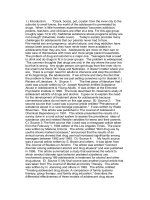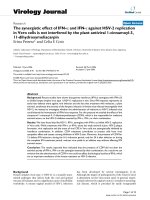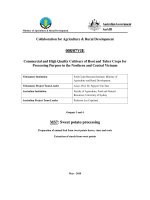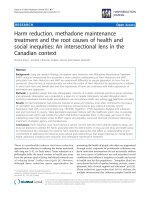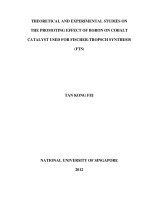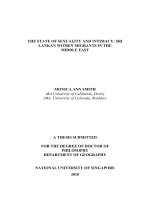Studies on effect of graded level of application of boron and potassium on arecanut (Areca catechu L.) and their interaction on boron content in the soil, leaf, nut and yield parameter in
Bạn đang xem bản rút gọn của tài liệu. Xem và tải ngay bản đầy đủ của tài liệu tại đây (236.43 KB, 8 trang )
Int.J.Curr.Microbiol.App.Sci (2019) 8(3): 1992-1999
International Journal of Current Microbiology and Applied Sciences
ISSN: 2319-7706 Volume 8 Number 03 (2019)
Journal homepage:
Original Research Article
/>
Studies on Effect of Graded Level of Application of Boron and Potassium
on Arecanut (Areca catechu L.) and their Interaction on Boron Content in
the Soil, Leaf, Nut and Yield Parameter in Terai Region of West Bengal
B.V. Supriya1*, P.S. Medda1 and A.K. Sinha2
1
2
Department of Plantation, Spices, Medicinal and Aromatic Crops, Faculty of Horticulture,
Department of Soil Science and Agriculture Chemistry, Faculty of Agriculture, Uttar Banga
Krishi Vishwavidyalaya, Punibari, West Bengal, India
*Corresponding author
ABSTRACT
Keywords
Arecanut
Areca catechu L.
Boron and
Potassium
Article Info
Accepted:
15 February 2019
Available Online:
10 March 2019
The experiment was conducted during the year 2017-18 at the instructional farm of
Department of Plantation Crops and Processing, Faculty of Horticulture, Uttar Banga
Krishi Vishwavidyalaya, West Bengal. The study was aimed to evaluate the effect of
graded level application of boron and potassium and their interaction on boron content in
soil, leaf and nut (mg/kg) and their interaction effect on yield parameter in the boron
deficient soils of terai region of West Bengal. The experiment was carried out in a 2.7×2.7
m spaced 12 year old planted with cv. Mohitnagar and laid out in factorial RBD having 12
treatments replicated 4 times with 4 different level of boron viz., B0, B1, B2 and B3 at 0g,
25g, 50g and sprayed with 4% Na2B4O7 solution along with 3 different level of potassium
(K2O) viz., K1, K2 and K3 at 70 g, 140 g, 210 g of K2O per palm respectively to the
bunches at 2nd, 4th and 6th months respectively per palm at nut development stage at regular
intervals. Soil and nut samples are collected from 10 equidistant spots and 10 different
palms respectively whereas leaf sample is collected from the 4 th index leaf (Ravi Bhat and
Sujatha, 2014) from 10 equidistant palms for analysis before and after application of
treatments. The results revealed that graded level application of boron and potassium
shows that at higher level of boron (B2) and potassium (K3) the boron content is gradually
increased in the soil, leaf and nut (mg/kg) and their interaction effect shows that, higher
level combination of both boron and potassium (B2K3) shows higher boron content in the
soil, leaf and nut (mg/kg) and at B3K2 and B2K2 level of interaction the yield parameters
shows significant effect.
Introduction
The Arecanut is the fruit of the areca palm
(Areca catechu) popularly known as betelnut
belongs to family arecaceae which grows in
much of the Tropical pacific (Melanasia and
Micronesia), South East Asia and South
Africa. It is mainly chewed with the betel
leaves, lime, with or without tobacco. The
value added form of consumption is by way of
1992
Int.J.Curr.Microbiol.App.Sci (2019) 8(3): 1992-1999
pan masala and scented supari. The nut has
got some medicinal and neutracritical
properties. It is health activator, mouth
freshner and has digestive properties.
Arecanut can be used for the following
purposes like masaj powder, soaps and
shampoos, cosmetics, antihelmintic and antidiabetic, areca wine making, areca soft drink,
ayurvedic type of thamboola for chewing
purpose, ulcer healing combination, hair oil
and dyes, food colours and skin ointments
(Prakash, 2010). Soil fertility is one of the
important factors controlling the crop yield;
soil related limitations affecting the crop
productivity including nutritional disorders
can be determined by evaluating the fertility
status of soils. Soil testing provides the
information about the nutrient availability of
the soil upon which the fertilizer
recommendation for maximizing crop yield is
made. Boron and Potassium nutrients plays a
vital role in the growth and development of
arecanut palm where all palms are potassium
lovers, required in larger quantity for the
development of nuts etc., hence it has to be
supplied to the plants in the adequate quantity,
both excess supply of minerals and limited
supply of nutrients leads to different problems.
Due to nutrient deficiency in Terai region soil
the plantation under this region are showing
greater extent of potassium and boron
deficiency which directly effect on nut
development which is leading to nut fall,
which ultimately reduces the yield of the crop,
hence in order to mitigate the problems faced
in these regions, it has to be studied
scientifically and need to give a solution for
all the problems facing related to soil micro
and macro nutrients by analyzing the soil, leaf
and nut boron and potassium content in
interaction with yield parameters.
Materials and Methods
The experiment was carried out during 201718 at the Instructional Plots of the Department
of Plantation Crops and Processing, Uttar
Banga Krishi Viswavidyalaya, West Bengal.
Physico-chemical properties of the soil
analysed by standard methods were soil
texture- sandy loam, pH - 5.45 (Jackson,
1973), electrical conductivity - 0.06 dsm-1
(Jackson, 1973), available N - 159. 62 kg/ha
(Alkaline KMnO4 method, Subbiah and Asija,
1956), available P - 23.15 kg/ha (Acid
extractable method, Bray and Kurtz, 1945),
available K – 145.3 kg/ha (1N ammonium
acetate method, Jackson, 1967), and available
B – 1.77 mg/kg (Hot water extractable as
proposed by Berger and Truog (1939). The
experiment was laid out in Factorial
Randomised Block Design with 12 treatments
replicated 4 times with 4 different level of
boron viz B0, B1, B2 and B3 at 0g, 25g, 50g
and sprayed with 4% Na2B4O7 solution along
with 3 different level of potassium (K2O) viz
K1, K2 and K3 at 70 g, 140 g, 210 g of K2O per
palm respectively to the bunches at 2nd, 4th and
6th months respectively per palm at nut
development stage at regular intervals. The 12
different treatment combinations were given
in Table 1.
All the palms which are under treatment had
given Nitrogen, Phosphorous, potassium and
the boron in the form of urea (46%), single
super phosphate (16% P2O5), muriate of
potash (60% K2O) and Borax (10.5 % B)
respectively. According to the treatment
details, the plams were applied with 4
different level of boron viz., B0, B1, B2 and B3
at 0g, 25g, 50g and sprayed with 4% Na2B4O7
solution along with 3 different level of
potassium (K2O) viz., K1, K2 and K3 at 70 g,
140 g, 210 g of K2O per palm respectively to
the bunches at 2nd, 4th and 6th months
respectively per palm at nut development
stage at regular intervals. A constant dose of
Nitrogen was applied in the form of Urea at
109g/palm and phosphorous (P2O5) at
125g/palm in two equal splits at pre and post
monsoon.
1993
Int.J.Curr.Microbiol.App.Sci (2019) 8(3): 1992-1999
Fertilizer are applied in basins around the
palm dug to a depth of 15-20cm and 0.75-1.0
m radius from the base of the palm and after
the application to the basins were thoroughly
mixed with the soil and covered with the top
soil. The fertilizer application as stated was
followed with light irrigation (Nathanael, 1967
and Dew saliva, 1968). The initial soil
samples 0-15 cm and 15-30 cm depth were
collected
randomly
throughout
the
experimental plots before commencement of
application of fertilizers mentioned in the
experimental details. The soil samples were
drawn from the selected from a Dutch Auger
(Make: AIC Agro-Industries Private Ltd,
Kolkata) as initial sample and later as final
sample after the completion of experiment.
The sample were collected from base of each
palm as separate treatment according to the
replication and maintained separately for
analysis. In the process, the bulk soil was
reduced to 1 kg by following the quartering
method. This 1 kg soil sample constituted the
composite soil sample. The composite soil
samples were then air dried, passed through a
2 mm sieve and stored in clean dry cloth bags
with adequate descriptions in attached paper
labels. All relevant information and
identification marks as required were also
recorded. These composite soil samples were
analysed in the laboratory for the required soil
characteristics and properties and some of the
parameters like pH (Jackson, 1973), electrical
conductivity (Jackson, 1973), available N
(Alkaline KMnO4 method, Subbiah and Asija,
1956), available P (Acid extractable method,
Bray and Kurtz, 1945), available (1N
ammonium acetate method, Jackson, 1967),
and available B (Hot water extractable as
proposed by Berger and Truog (1939) has
been analysed and also Leaf samples were
collected from the 4th index leaf (Bhat and
Sujatha, 2014) from 10 equidistant palms for
analysis before application of the fertilizer and
after completion of the experiment from each
palm as per the treatment, 4 samples were
collected from each treatment and the bulking
of sample and kept separately for analysis and
then determination of boron and potassium
content in the leaf sample were done.
The collected leaf samples were brought to the
laboratory and washed immediately with tap
water and then rinsed with 0.1 N HCl. The
washed and rinsed samples were dried under
shade followed by oven drying at a
temperature of 65±5 ºC so as to reduce the
chemical and biochemical changes to the
minimum. The oven dried samples were
powdered and stored in butter paper bags for
chemical analysis. In the same way nut
samples were collected after oven drying the
dehusked arecanut, the kernel was dried
separately in the oven after separating husk
and kernel and then the kernel was grinded,
powdered again oven dried and it was kept
separately according to the treatment with its
replication and proceeded for analysis for both
leaf and nut samples of both boron and
potassium content has been analysed using
Azomethin- H method and wet digestion
method by using tri-acid respectively.
Results and Discussion
Effect of graded level of application of
boron and potassium and their interaction
on Boron content in soil, leaf and nut
(mg/kg)
Effect of boron and potassium application
and their interaction on boron content in
the soil (mg/kg)
Soil analysis data recorded a higher
concentration of boron recorded a higher
concentration of boron in the soil even at
without application of boron (1.28 mg/kg) and
showed directly proportionate relationship to
the application of boron. The treatment
comprising of without application of boron
(B0) and bunch spraying (B3) recorded
1994
Int.J.Curr.Microbiol.App.Sci (2019) 8(3): 1992-1999
statistically at par data. As per the analyzed
data, it is observed that B2 (2.52 mg/kg) (Fig.
1) shows significantly higher boron content in
the soil and B0 level (1.28 mg/kg) recorded
lower boron content in the soil and also boron
content in the soil may also varies based on
application of potassium fertilizers at different
grades data revealed that treatment K3 (2.24
mg/kg) showed significantly higher boron
content in the soil and K1 (1.43 mg/kg) (Table
2; Fig. 1) shows significantly lower boron
content.
In the interaction effect of both boron and
potassium, the experiment data revealed that
B2K3 (3.58 mg/kg) recorded significantly
higher boron content in the soil followed by
B2K1 (2.13 mg/kg) and B1K3 (2.06 mg/kg) and
at the same time B0K1 (0.91 mg/kg) (Table 2;
Fig. 2) showed significantly lower boron
content in the soil. On the other hand bunch
spraying of 0.4% borax recorded an increasing
trend of boron concentration of soil with the
increasing application of K in the soil. From
the above result it may be concluded that the
experimental soils recorded higher boron
concentration might be due to regular
application of boron into the soil and its
concentration increased due to increased rate
of soil application of boron.
Effect of boron and potassium application
and their interaction on boron content in
the leaf (mg/kg)
The boron content of the index leaf also
observed a similar trend as in case of soil B2
level of boron application recorded
significantly higher boron content in the leaf
(Fig. 1) and B0 showed lowest boron content
in the soil (181.82 mg/kg) (Table 2; Fig. 1)
where as K1 and K2 level of application
recorded significantly lower boron content in
the leaf.
Interaction effect of boron and potassium on
boron concentration in leaf revealed that B2K3
(225.20 mg/kg) shows significantly higher
boron content in the leaf may be due to higher
presence of boron in the soil, followed by
B3K1 (208.13 mg/kg) (Table 2; Fig. 2) and at
the same time B0K1 recorded significantly
lower boron content in the leaf (109.40
mg/kg).
Effect of boron and potassium application
and their interaction on boron content in
the nut (mg/kg)
Boron concentration in the nut under the
treatments is also showed significantly
increasing trend as reflected in leaf boron
concentration of the palms with the increase in
soil application of both the elements and
subsequently, B2 and K2 level of application
recorded 51.63 mg/kg and 43.18 mg/kg
respectively. Without application of boron
recorded significantly lowest boron content
(24.93 mg/kg) followed by bunch spraying of
0.4% borax (28.40) (Table 2; Fig. 1). The
interaction effect of both boron and potassium
on boron content in nut reveals the B2K3
(87.06 mg/kg) is having significantly higher
boron content in the nut followed by B1K2
(48.30 mg/kg) and B2K2 (37.77 mg/kg) (Fig.
2) but at the same time B0K1 (19.73 mg/kg)
(Table 2; Fig. 1) shows significantly lower
boron content in the nut due to lower boron
content in the soil as well as leaf.
Interaction effect of boron and potassium
application on fresh kernel weight (g) and
Dry kernel weight (g)
Interaction effect of boron and potassium
application on fresh kernel weight (g)
The results with respect to the effect of boron
and potassium at different levels indicated that
B3K2 (13.03 g) (Fig. 3) produced significantly
higher kernel weight and was at par with
remaining all 10 treatments but B2K1 (10.18 g)
(Fig. 3) produced significantly lower kernel
weight.
1995
Int.J.Curr.Microbiol.App.Sci (2019) 8(3): 1992-1999
Table.1 Treatment details
T1: B0K1
T2: B0K2
T3: B0K3
T4: B1K1
T5: B1K2
T6: B1K3
T7: B2K1
T8: B2K2
T9: B2K3
T10: B3K1
T11:B3K2
T12: B3K3
0 g borax/palm (0g B) + 70 g K2O/palm
0 g borax/palm (0g B) + 140 g K2O/palm
0 g borax/palm (0g B) + 210 g K2O/palm
25 g borax/palm(2.63g B) + 70 g K2O/palm
25 g borax/palm (2.63g B) + 140 g K2O/palm
25 g borax/palm (2.63g B) + 210 g K2O/palm
50 g borax/palm(5.25g B) +70 g K2O/palm
50 g borax/palm (5.25g B) +140 g K2O/palm
50 g borax/palm (5.25g B) + 210 g K2O/palm
Spray 0.4% Na2B4O7 +70 g K2O/palm
Spray 0.4% Na2B4O7 + 140 g K2O/palm
Spray 0.4% Na2B4O7 + 210 g K2O/palm
Table.2 Effect of graded level of application of boron and potassium and their interaction on
Boron content in soil, leaf and nut (mg/kg)
Treatment
B0
B1
B2
B3
S.Em(±)
C.D. (0.05)
K1
K2
K3
S.Em(±)
C.D(0.05)
B0K1
B0K2
B0K3
B1K1
B1K2
B1K3
B2K1
B2K2
B2K3
B3K1
B3K2
B3K3
S.Em(±)
C.D(0.05)
Boron content in the soil
(mg/kg)
1.28
1.76
2.52
1.45
0.08
0.23
1.43
1.58
2.24
0.07
0.19
0.91
1.45
1.49
1.45
1.77
2.06
2.13
1.85
3.58
1.24
1.27
1.85
0.13
0.39
Boron content in the
leaf (mg/kg)
147.84
174.52
200.54
170.53
1.52
4.45
168.86
169.41
181.82
1.31
3.86
109.40
113.00
121.13
153.13
180.47
189.97
204.77
171.67
225.20
208.13
190.97
112.50
2.63
7.71
1996
Boron content in the
nut (mg/kg)
24.93
34.79
51.63
28.40
0.72
2.12
27.27
34.43
43.18
0.63
1.83
19.73
26.77
28.30
27.30
48.30
28.77
30.07
37.77
87.06
24.97
31.93
28.30
1.25
3.67
Int.J.Curr.Microbiol.App.Sci (2019) 8(3): 1992-1999
Table.3 Interaction effect of boron and potassium application on fresh kernel weight (g) and dry
kernel weight
Treatment
Fresh kernel weight (g)
Dry kernel weight (g)
B0K1
B0K2
B0K3
B1K1
B1K2
B1K3
B2K1
B2K2
B2K3
B3K1
B3K2
B3K3
S.Em(±)
C.D.(0.05)
11.34
12.32
12.64
12.41
12.74
12.33
10.18
12.94
11.84
10.82
13.03
12.53
0.64
1.88
3.00
3.61
3.01
3.26
3.01
3.09
3.01
3.88
3.11
3.00
3.73
3.44
0.29
0.85
Fig.1 Effect of graded level of application of boron and potassium on boron content in soil, leaf
and nut (mg/kg)
1997
Int.J.Curr.Microbiol.App.Sci (2019) 8(3): 1992-1999
Fig.2 Interaction effect of graded level of application of boron and potassium on boron content in
soil, leaf and nut (mg/kg)
Fig.3 Interaction effect of boron and potassium application on fresh kernel weight (g) and dry
kernel weight
The data suggested that bunch spray with
higher dose of potassium had a significant
effect at lower boron concentration in soil and
helped potassium play a role in physiological
activity.
Interaction effect of boron and potassium
application on dry kernel weight (g)
Interaction effect of both minerals, the
experimental data reveals that B2K2 (3.80 g)
level shows significantly higher dry kernel
1998
Int.J.Curr.Microbiol.App.Sci (2019) 8(3): 1992-1999
weight followed by B3K2 (3.73 g) and B0K2
(3.61 g) (Table 3; Fig. 3) as noticed with
respect to fresh kernel weight, may be due to
better combination of both nutrients and B0K1
level of application recorded significantly
lower dry kernel weight(3.00 g) due to lower
availability and ultimately reflected in dry
matter accumulation.
From the experiment we can conclude that the
graded levels of boron and potassium and
their interaction indicated that there was a
significant increase in boron level of soil, leaf
and nut with increase level of soil application
of boron and potassium. The interaction of
both the elements was also showed the similar
effect with respect to boron concentration
In the present experiment, yield attributing
characters of the arecanut have also observed
varied response with application of different
combination of boron and potassium. Soil
application of 25 g boron and 140 g
potassium per palm recorded the maximum
fresh kernel weight of the nuts and dry kernel
weight recorded its maximum value with
bunch spray along with soil application of 140
g potassium. However, the treatment
combination B3K2 performed the best with
respect to fresh kernel weight and B2K2
performed the best with respect to dry kernel.
Better yield of arecanut cv Mohitnagar can be
achieved through combined soil application of
25 g borax with 140 g potash along with 100
g nitrogen and 40 g phosphorous. Regular soil
application of boron increases the boron
concentration of soil, leaf and nut which
hinders the increased uptake of potassium.
References
Berger, K.C. and Truog, E. (1939). Boron
determination in soils and plants.
Industrial Engineering Chemistry, 11:
540 - 545.
Bhat and Sujatha, S. (2014). Nutrient
management in arecanut. Indian
Journal of Arecanut, Spices and
Medicinal plants, 16(4).
Bray, R.H. and Kurtz, L.P. (1945).
Determination of total, organic and
available forms of phosphorus in soils.
Soil Science, 59: 39-45.
Jackson, M.L. (1967). Soil Chemical
Analysis. Prentice Hall of India Private
Limited, New Delhi.
Jackson, M.L. (1973). Soil chemical analysis,
Prentice Hall of India, Pvt. Ltd., New
Delhi.
Nathanael, W.R.N. (1967). The application of
fertilizer to adult coconut palms in
relation to theoretical aspects. Ceylon
Coconut Quarterly, 18:1- 30.
Prakash, T.N. (2010). Special scheme on cost
of cultivation of arecanut from
Karnataka, Department of Agricultural
Economics, University of Agricultural
Sciences, Bangalore.
Subbiah, B.V. and Asija, G.L. (1956). A rapid
procedure for determination of available
nitrogen in soils. Cur. Sci., 25: 259-260.
How to cite this article:
Supriya, B.V., P.S. Medda and Sinha, A.K. 2019. Studies on Effect of Graded Level of
Application of Boron and Potassium on Arecanut (Areca catechu L.) and their Interaction on
Boron Content in the Soil, Leaf, Nut and Yield Parameter in Terai Region of West Bengal.
Int.J.Curr.Microbiol.App.Sci. 8(03): 1992-1999. doi: />
1999

